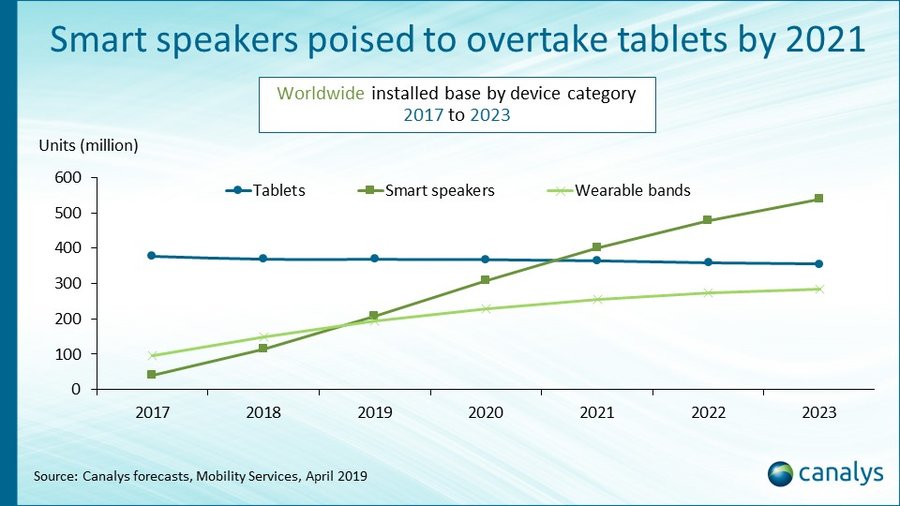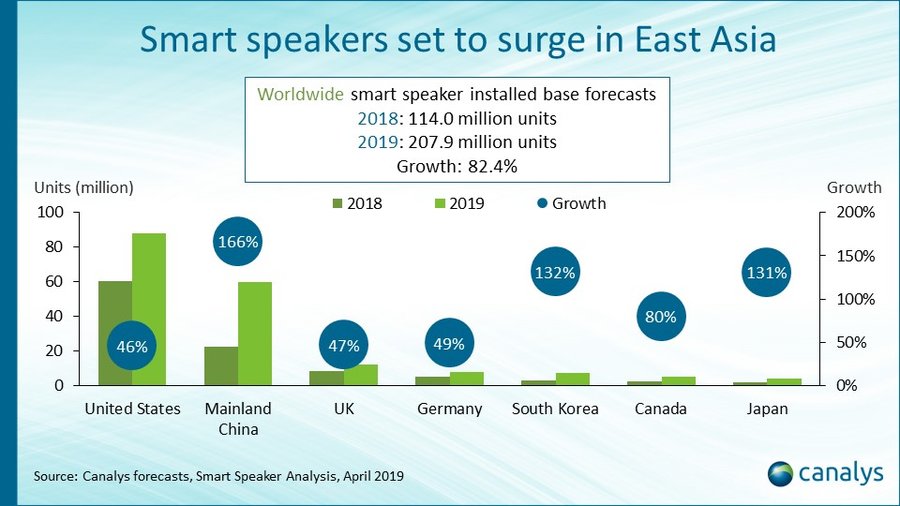More users are opting to put their tablets down and turn to the smart speaker for their browsing preferences.
In with the New
As an increasing amount of people adopt more smart speakers into their homes and vehicles, the technology will soon be leap frogging other types of devices that seemed revolutionary not too long ago. The installed base of Google Homes, Amazon Echos, and Apple HomePods is poised to exceed the number of people who are using tablets by 2021, with an expected 400 million smart speakers to be in use.
This discovery - which was mentioned in a new global market report produced by Canalys - also stated that by the end of 2019, the worldwide smart speaker market will grow by 82%, to 207.9 million units.

Image Source: Canalys
Regional Gains
From a geographical standpoint, the United States is currently considered to be the most mature market in terms of usage and installed base. By the end of the year, Canalys predicts its smart speaker market will rise by 46%.
Interestingly, it’s the Asian markets that’s expected to have the most significant growth this year, as China (166%), South Korea (132%), and Japan (131%) are all set to provide larger growth opportunities due to the number of middle-class homes and working population that are adopting the technology.

Image Source:Canalys
It’s not just the Eastern hemisphere that’s seeing voice usage swell either. Canada (80%), Germany (49%), and the United Kingdom (47%) will all be seeing their citizens warm to smart speakers in 2019.
Business Lag
Despite the tremendous amount of growth we’re seeing across the globe, there is still a large gap in terms of adoption hype, and how brands are leveraging the technology from a commerce perspective.
A previous report conducted by Speedpay® Pulse painted a lackluster picture for the future of voice commerce, stating that only 7.4% of Americans that own a smart speaker have engaged the device to make a digital payment of some kind.
It was also recently revealed that it’s not simply voice commerce that’s moving at a snails base in comparison with smart speaker adoption. Businesses are also struggling to find ways to effectively optimize their assets to capitalize on voice-related searches, with only 4% of them being adequately prepared to facilitate the new source of digital traffic.
Fortunately, there is a silver lining with all of these findings. Younger demographics have become one of the key drivers for embracing voice technology and using it in more sophisticated ways than their older counterparts. 34% of those in between the ages of 18-22, and 39% of those aged 23-34 have stated that their willing to make digital payments using a smart speaker, which means that as those demographics gain more purchasing power, it could tilt the scale and expedite the current lag happening in the space.
Capitalizing Early
Just because things aren’t moving quickly in the voice commerce realm, doesn’t mean that it isn’t a good time for brands and marketers to act. It’s in this time of unpreparedness that brands who do provide a good digital voice experience stand to reap serious benefits.
Those who are looking to get a leg up on the competition have a variety of options available. For starters, start doing some research around the types of questions people may be asking online that your offering can solve, and adding long-tailed semantic search terms to your list of keywords to optimize accordingly.
We also recently learned that there are some parallels to be drawn between local optimization and voice search indexing, meaning that you should take the steps to ensure that your local information like business name, address, hours of operation, and phone number are all easy to find on your website.
There are other ways to take advantage of the voice commerce surge as well, like designing your own voice app (Amazon’s Alexa Skills Kit allows companies to do this), or boosting your site speed, which is an extremely critical factor considering that people using their smart speakers expect answers to their questions within seconds.
Finally, if you’ve done all of the above steps and you’re still looking for inspiration, try looking at what some of the major players are doing. Both Target and Walmart have taken some creative approaches recently to make their products and services more compatible with voice purchases.
At the end of the day, there’s clearly still going to be some time before we really see smart speakers make a significant impact on the commerce industry as a whole, but any small step that can be made to improve the voice experience is a step in the right direction.
